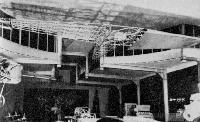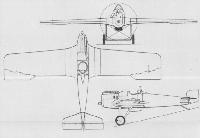O.Thetford, P.Gray German Aircraft of the First World War (Putnam)
Junkers J 2
As a development of the J 1, six J 2s (also designated E I) were built in 1916. Serials 250/16 to 255/16 were allocated, 252/16 having the more powerful 160 h.p. Mercedes D III engine fitted. Engine 120 h.p. Mercedes D II. Span, 11 00 m. (36 ft. 1 1/8 in.). Length, 7.3 m. (23 ft. 11 3/8 in.). Height, 3.13 m. (10 ft. 3 1/4 in.). Area, 19.84 sq.m. (214 sq.ft.). Weights: Empty, 1018 kg. (2,240 lb.). Loaded, 1,160 kg. (2,486 lb.). Speed, 145 km.hr. (90.625 m.p.h.). Armament, one Spandau machine-gun.
Junkers J 3
Scheduled as a further development of the E type monoplanes, the J 3 would have been the first machine to be covered with the famous corrugated sheet covering. Although the airframe was never completed, the remains were preserved, as may be seen in the illustration, which also gives a good idea of the tubular basic framework of these Junkers machines. A rotary engine was scheduled for installation, and the span was 11.0 m. (36 ft. 1 1/8 in.).
W.Green, G.Swanborough The Complete Book of Fighters
JUNKERS J 2 Germany
Following the successful demonstration in December 1915 of the Junkers J 1 all-steel two-seat experimental aircraft, Junkers und Compagnie of Dessau was awarded a contract by the Inspektion der Fliegertruppen (Idflieg) on 31 January 1916 for six examples of a single-seat fighter derivative, the J 2. The first example, powered by a 120 hp Mercedes D II water-cooled engine and carrying an armament of one LMG 08/15 machine gun, was flown at Doberitz on 11 July 1916. As a result of flight trials, a number of changes were introduced on the subsequent five aircraft which were powered by the 160 hp Mercedes D III engine. Overall length was increased marginally, wing span was extended by 27 1/2 in (70 cm), wing area reduced by 9 sq ft (84 cm2), long-span, shorter-chord ailerons were fitted and the forward fuselage contours revised. In its definitive form, the J 2 was 9 mph (15 km/h) faster than the best contemporary fighter and its handling characteristics were good, but because of the weight of its all-steel construction, climb rate was below the then current combat requirements. View from the cockpit was considered inadequate, and Idflieg coolness towards the fighter increased still further when a J 2 crashed on 23 September 1916, killing test pilot Max Schade. No further examples were ordered in consequence. The following data relate to the definitive model.
Max speed, 124 mph (200 km/h).
Time to 9,840 ft (3 000 m), 21 min.
Empty weight, 2,244 lb (1018 kg).
Loaded weight, 2,568 lb (1165 kg).
Span, 38 ft 4 2/3 in (11,70 m).
Length, 24 ft 4 1/2 in (7,43 m).
Height, 10 ft 3 1/4 in (3,13 m).
Wing area, 204.52 sqft (19,00 m2).





